Summary
Women who visited hospitals requesting induced abortions were asked about their obstetric and medical histories by attending physicians prior to the operation. The information was solely based on their reports at the interview. The period of coverage was nine weeks, comprising six weeks before and three weeks after the onset of the last menstruation. Both the occurrence of acute respiratory infectious diseases, which included the common cold, upper respiratory tract infection (U.R.T.I.), influenza, and pneumonia, and the use of analgesics and antipyretics were most frequently reported. Regardless of whether they had an acute respiratory illness, the women who took analgesics and antipyretics (including antihistamine, cough remedy, and nasal decongestant) had 13.8% (8/58) gross chromosome anomalies. The women without the treatment had 6.3% (71/1136) anomalies. The difference was statistically significant (P<0.05). Triploid formation was particularly related to drug consumption, thus there were 5.2% (3/58) in the treated group and 0.5% (6/1136) in the untreated group (P=0.0074). In contrast, trisomy was not considered to be related to drug consumption on account of 8.6% (5.58) and 4.1% (47/1136) in the corresponding groups (0.10<P<0.20). When the occurrence of trisomy was examined in connection with two variables, i.e., the presence of drug consumption and the age of mothers, association was not evident (χ2 assoc.=0.883,d.f.=1 by Cochran.s method). Besides these results, neither maternal X-irradiation nor irregularity of the menstrual period was found to be related to the frequency of chromosome anomalies in the progeny.
Similar content being viewed by others
References
Alberman E, Polani PE, Roberts JAF, Spicer CC, Elliot M, Armstrong E, Dhadial RK (1972) Parental X-irradiation and chromosome constitution in their spontaneously aborted foetuses. Ann Hum Genet 36:195–208
Barthelmess A (1970) Mutagenic substances in the human environment. In: Vogel E, Röhrborn G (eds) Chemical mutagenesis in mammals and man. Springer-Verlag, Berlin Heidelberg New York, pp 69–147
Fleiss JL (1973) Combining evidence from fourfold tables. In: Statistical methods for rates and proportions. John Wiley and Sons, New York, pp 109–129
Schull WJ, Neel JV (1962) Maternal radiation and mongolism. Lancet i:537–538
Shaw MW (1970) Human chromosome damage by chemical agents. Ann Rev Med 21:409–432
Stevenson AC, Mason R, Edwards KD (1970) Maternal diagnostic X-irradiation before conception and the frequency of mongolism in children subsequently born. Lancet ii:1335–1337
Uchida IA, Curtis EJ (1961) A possible association between maternal radiation and mongolism. Lancet ii:848–850
Vogel F (1970) Spontaneous mutation in man. In: Vogel F, Röhrborn G (eds) Chemical mutagenesis in mammals and man. Springer-Verlag, Berlin Heidelberg New York, pp 16–68
Watanabe M, Ito T, Yamamoto M, Watanabe G (1978) Origin of mitotic cells of the chorionic villi in direct chromosome analysis. Hum Genet 44:191–193
Yamamoto M, Fujimori R, Ito T, Kamimura K, Watanabe G (1975) Chromosome studies in 500 induced abortions. Hum Genet 29: 9–14
Yamamoto M, Ito T, Watanabe G (1976) Eine weitere Chromosomenanalyse bei künstlichen Aborten. Hum Genet 34:69–71
Yamamoto M, Watanabe G (1978) Cause of fetal deaths. 1) Chromosome anomalies and fetal deaths. Shuzanki Igaku (Perinatal Medicine) 8:28–34
Yamamoto M (1979) Drugs and chromosome anomalies. Shuzanki Igaku (Perinatal Medicine) 9:95–100
Yamamoto M, Watanabe G (1979) Epidemiology of chromosome anomalies at the early stage of pregnancy. In: Contribution to epidemiology and biostatistics. S Karger, Basel, pp 101–106
Author information
Authors and Affiliations
Rights and permissions
About this article
Cite this article
Yamamoto, M., Ito, T., Watanabe, M. et al. Causes of chromosome anomalies suggested by cytogenetic epidemiology of induced abortions. Hum Genet 60, 360–364 (1982). https://doi.org/10.1007/BF00569219
Received:
Issue Date:
DOI: https://doi.org/10.1007/BF00569219




